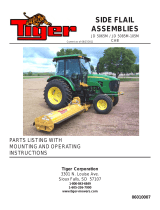
SAFETY
INFORMATION
Preparation
Always wear relatively tight and belted clothing
to avoid entanglement in moving parts. Wear
sturdy, rough
-
soled work shoes and protective
equipment for eyes, hands, hearing and head.
Ensure that mower is properly mounted, ad
-
justed and in good, operating Condition.
Make sure mower driveline spring
-
activated
locking collar slides freely and the balls are
seated in mid
-
PTO shaft groove.
Remove accumulated debris from mower to
avoid
fire
hazard.
Ensure all safety decals are installed and in
good condition. (See Safety Decals section for
location drawing.)
:
Ensure shields and guards are properly in
-
stalled and in good condition.
A
minimum
20%
of tractor and equipment
weight must be on tractor front wheels with
mower in transport position. Without this
weight, tractor could tip over causing personal
injury
or
death. The weight may be attained with
front wheel weights, ballast in tires
or
front
tractor weights. When attaining the minimum
20%
weight on the front wheels, you must not
exceed the Roll Over Protection Structure
(ROPS)
weight certification. Weigh the tractor
and equipment.
Do
not estimate.
branches
or
other hard objects that might be
thrown, causing injury
or
damage.
Inspect area to be cut and remove stones,
Operational Safety
You may not be able to stop the tractor safely
if
the clutch or brake pedal mechanisms are
improperly adjusted, allowing them to contact
mower components.
instructed in this manual, properly adjusted
clutch and brake pedal mechanisms
will
not
contact mower components. You should
frequently check that the tractor clutch and
brake pedal mechanisms are in adjustment.
If the clutch
or
brake pedal mechanisms can
contact mower components, do not operate
until properly adjusted.
Do not operate mower unless discharge chute
is
installed.
Keep bystanders away from equipment while it
is
in operation.
Never direct discharge toward anyone.
Operate only in daylight or good artificial light.
Keep hands and feet away from mower while
tractor engine is running.
Stay clear of all moving parts.
If your tractor is equipped with a
ROPS,
you
No
riders are allowed on tractor
or
mower.
Start engine from operator's seat after disen
-
When the mower lift stops are installed as
must wear your seat belt.
gaging tractor PTO and placing transmission in
neutral.
engine or operating controls.
neutral, and place all controls in neutral before
starting tractor engine.
Operate tractor mid
-
PTO at no more than
2400
RPM
(maximum governed engine
RPM).
Make sure area behind'you
is
clear before
operating in reverse.
Do
not operate on steep slopes.
Do
not stop, start or change directions sud
-
Use extreme care and reduce ground speed
Watch for hidden hazards on the terrain during
Always sit in tractor seat when starting the
Disengage power
-
take
-
off
,
shift tractor into
denly on slopes.
on slopes and rough terrain.
operation.
5
























